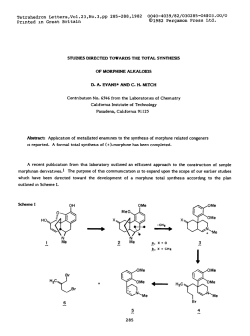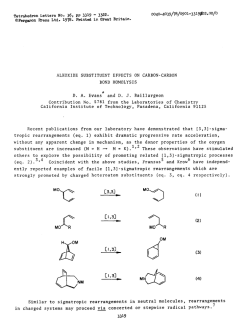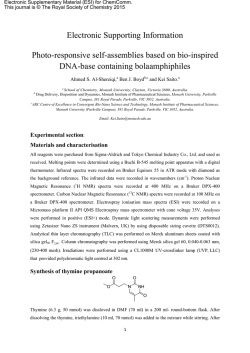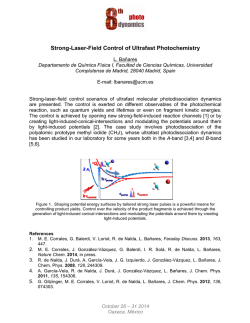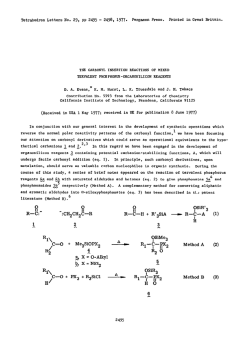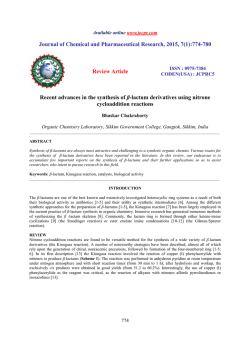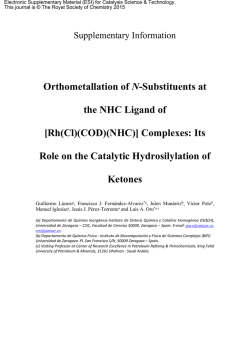
Efficient synthetic method for β-enaminones using SbCl3/Al2O3 as
Available online www.jocpr.com Journal of Chemical and Pharmaceutical Research, 2015, 7(1):823-828 Research Article ISSN : 0975-7384 CODEN(USA) : JCPRC5 Efficient synthetic method for β-enaminones using SbCl3/Al2O3 as catalyst under solvent-free conditions Mohd. Yaseen Sirwal1, Rajan Kumar Sharma2 and Kamal K. Kapoor2 1 2 Govt. Degree College, Kishtwar, Jammu and Kashmir, India Department of Chemistry, University of Jammu, Jammu, India _____________________________________________________________________________________________ ABSTRACT Antimony trichloride is found to catalyze efficiently the synthesis of β-enaminones on grinding under solvent-free conditions in excellent yields. The use of antimony trichloride on grinding makes this method simple, convenient, eco-friendly and cost-effective. O O O Ar-NH2 SbCl3 / Al2O3 (2 mol% ) H N Ar Grinding, RT Keywords: SbCl3/Al2O3; β-enaminones; solvent-free; grinding. _____________________________________________________________________________________________ INTRODUCTION Enaminones are known to possess a variety of medicinal properties[1] including anticonvulsant, anti-malarial, antiinflammatory and cardiovascular properties.[2] The β-enaminones are important precursors for the synthesis of a variety of heterocycles[3] with high pharmaceutical significance. They serve as building blocks for the synthesis of amino esters, amino acids, amino alcohols, peptides and alkaloids.[4] The enamination of 1,3-dicarbonyl compounds to form β-enaminones is an important and widely used transformation in organic chemistry. Several methods are known in the literature for the preparation of β-enaminones. Among them the most commonly used methods involve condensation of 1,3-dicarbonyls with aliphatic and aromatic amines using Sc(OTf)3,[5] Bi(OTf)3,[6] Au,[7] Zn(OAc)2.2H2O,[8] silica[9] etc. Keeping in view the biological importance [1],[2] of β-enaminones, we present here antimony (III) chloride adsorbed on alumina catalyzed mild, efficient and inexpensive procedure for the preparation of β-enaminones from acetylacetone and aromatic amines in solvent-free conditions. A remarkable catalytic effect of antimony (III) chloride was disclosed by Cho’s group[10] in hydrophenylation of α,β-unsaturated ketones and aldehydes (Michaeltype conjugate addition) with sodium tetraphenylborate in acetic acid. SbCl3 has been found to catalyze efficiently the synthesis of 1,2-di-substituted benzimidazoles,[11] benzo[b]-1,4-diazepines,[12] tetra-substituted imidazoles,[13] bis(indolyl)methanes and tris(indolyl)alkanes,[14] α-aminophosphonates,[15] dihydro pyrimidinones[16] etc. In continuation of our ongoing efforts into the applications of SbCl3 impregnated on inorganic supports as a post transitional Lewis acid in organic synthesis, we wished to employ SbCl3 impregnated on Al2O3[16] under solventfree conditions for the synthesis of β-enaminones. The reactions under solvent-free conditions enjoy benefits[17] in terms of easy handling by reducing the pressure development in reaction vessel, simple equipment of operation, less 823 Mohd. Yaseen Sirwal et al J. Chem. Pharm. Res., 2015, 7(1):823-828 ______________________________________________________________________________ environmentally hazardous conditions by avoiding use of harmful solvents, time and energy efficiency, low capital outlay for scale up, reduction in the waste produced and by products and formation of cleaner products. EXPERIMENTAL SECTION General All experiments were performed in oven dried glass apparatus. Melting points were measured in open capillaries on Perfit melting point apparatus and are uncorrected. The progress of the reaction was monitored by TLC using silica gel precoated aluminium sheets. Visualization of spots was effected by exposure to iodine vapours and Draggendroff reagent. Column chromatography was performed on silica gel (60-120 mesh) and compounds were eluted with graded solvent systems of petroleum ether and ethyl acetate. Recrystallization was achieved with ethyl acetate-petroleum ether (60-80) solvent system. IR spectra on KBr were recorded on Perkin-Elmer FTIR spectrophotometer. NMR (1H and 13C broadband decoupled) and ESIMS spectra were recorded on Brucker Ac-500 (500 & 125 MHz respectively) spectrometer and Micro Mass VG-7070H mass spectrometer respectively. Elemental analysis was performed on Leco CHNS 932 analyzer. 1H chemical shifts are reported in parts per million (ppm) from tetra methyl silane (TMS) as internal standard. The abbreviations s, brs, d, dd, t, q, b, m in 1H NMR spectra refer to singlet, broad singlet, doublet, double doublet, triplet, quartet, broad and multiplet respectively. Preparation of catalyst (SbCl3 / Al2O3)[16] To an antimony (III) chloride (2.28gm, 10 mmol) solution in 100ml of distilled ethanol was added 60 gm of neutral alumina. The mixture was stirred at room temperature for one hour followed by removal of solvent under reduced pressure on rotavapour. The resultant free flowing powder was then activated at 110oC in an oven for two hours and was used throughout the experimentation. General procedure for the synthesis of β-enaminones(3a-3f) A mixture of acetylacetone (5 mmol), aniline 2a-2f (5.5 mmol) and 2 mol% SbCl3/Al2O3 (0.25 mmol, 0.62g) was grinded using pestle and mortar at room temperature till the completion of reaction (TLC). The reaction mixture was diluted with ethyl acetate (30 ml), washed with water (2 x 10 ml) and brine (1 x 10 ml). The organic layer was dried over anhydrous Na2SO4, followed by the removal of ethylacetate under reduced pressure. The residue upon column chromatography gave corresponding β-enaminones 3a-3f (85-93% yield). RESULTS AND DISCUSSION We herein report an efficient, simple and eco-friendly method for the preparation of β-enaminones by condensation of acetylacetone and aromatic amines in presence of SbCl3/Al2O3 on grinding under solvent-free conditions (Scheme 1). O SbCl3 / Al2O3 (2 mol% ) O O H N Ar Ar-NH2 Grinding, rt 1 2a-2f 3a-3f Scheme 1: SbCl3/Al2O3 catalyzed solvent-free synthesis of β-enaminones on grinding For optimization of reaction conditions a mixture of acetylacetone (5 mmol, 0.50g), aniline (5.5 mmol, 0.51g) and 5 mol% SbCl3/Al2O3 as catalyst was heated at 100°C under solvent-free conditions for 2 hours and the yield of the product was 55%. Few other methodologies were also employed like microwave irradiation, stirring, grinding and ultrasonication and the best results were obtained in case of grinding with 82% yield of the product. In order to obtain the optimum concentration of catalyst a set of experiments were performed employing different concentrations of SbCl3/Al2O3 for a reaction between 5 mmol acetylacetone and 5.5mmol of aniline and it was observed that 2mol% of catalyst was required to obtain the optimum yield (92%) of the product after one hour of grinding as shown in the Table 1. It has also been observed in one of the experiment devoid of SbCl3/Al2O3, that the product formation did occur (TLC), but the reaction never went to completion even after 8 hours of grinding. 824 Mohd. Yaseen Sirwal et al J. Chem. Pharm. Res., 2015, 7(1):823-828 ______________________________________________________________________________ Table 1 : Optimization of amount of SbCl3/Al2O3 for synthesis of β-enaminones under solvent-free conditions.b Entry 1 2 3 4 5 b Time(mins)c 60 60 60 60 60 Catalyst amount (mol%) 0 2 5 7 9 Yield(%)d 20 92 91 90 92 reaction conditions: acetylacetone (5 mmol), aniline (5.5 mmol) and SbCl3/Al2O3, grinding, 60 minutes. c as revealed by TLC. d isolated yield. In order to investigate the recyclability, SbCl3/Al2O3 was recovered, activated at 110°C in an oven and reused 5 times, successfully for the reaction of acetylacetone and aniline, no significant decrease in its activity was noticed (Fig.1). 100 Yield% 90 80 70 60 0 1 2 3 4 5 6 Cycles Fig. 1 Catalyst recyclability The condensation of acetylacetone (5 mmol, 0.50g) with aniline, (5.5 mmol, 0.51g) was carried out by grinding using pestle and mortar at room temperature under solvent-free conditions with 2 mol% SbCl3/Al2O3 as catalyst. The product 3a was characterized by 1H NMR spectrum [1.99 (s, 3H, -CH3), 2.10 (s,3H, -CH3), 5.19 (s, 1H, C=CH), 7.09-7.31 (m, 5H, Ar-H), 12.49 (br s, 1H, NH)] and supported by IR and Mass data. A characteristic singlet for one alkenic hydrogen at δ 5.19 arising due to the formation of 4-(phenylamino)–pent–3–en–2–one 3a.A variety of anilines 2a-2f were employed with acetylacetone 1 under the same reaction conditions (Scheme 1) and the results are depicted in Table 2. Table 2. Substrate scope for the SbCl3/Al2O3 catalyzed preparation of β-enaminones on grinding under solvent-free conditions.a Entry β-enaminoketonesb Ar-NH2 NH2 O M.pt(°C) Obs. Litt.e Time (min.)c Yield (%)d 55 92 Oily Oily[18] 53 93 Oily Oily[18] H N 1 3a 2a NH2 O H N OCH3 2 OCH3 3b 2b 825 Mohd. Yaseen Sirwal et al J. Chem. Pharm. Res., 2015, 7(1):823-828 ______________________________________________________________________________ Entry β-enaminoketonesb Ar-NH2 NH2 O M.pt(°C) Obs. Litt.e Time (min.)c Yield (%)d 62 93 66-68 65-67[19] 70 86 Oily Oily[18] 68 90 61-62 60-62[18] 65 88 59-60 -- H N CH3 3 3c CH3 2c NH2 H O N F 4 F 3d 2d NH2 H O N Cl 5 Cl 3e 2e NH2 H O Br N 6 Br 3f 2f a reaction conditions: acetylacetone (5 mmol), aniline (5.5 mmol) and SbCl3/Al2O3, grinding, 60 minutes. b all the products were characterized by their physical and spectral data. c as revealed by TLC d isolated yields. e literature reference of melting point. To explain the formation of desired product following plausible mechanism is proposed. The formation of βenaminones simply involves the formation of imine by the condensation of amino group and carbonyl group of different reactants followed by 1,3 H-shift leading to the formation of more stabilized β-enaminones due to intramolecular H-bonding as shown in Scheme-2. Hydrogen bonding SbCl3/Al2O3 H O O O N Ar H2N-Ar .. O N Ar H Ketoimine Scheme-2: Plausible mechanism for the synthesis of β-enaminones 826 Enaminones Mohd. Yaseen Sirwal et al J. Chem. Pharm. Res., 2015, 7(1):823-828 ______________________________________________________________________________ Spectroscopic data of some β-enaminones (3a-3f) 4-(Phenylamino)-pent-3-en-2-one (3a) Viscous oil, Pale yellow, 92% yield, M. pt. Oil [lit.[18] oil]. 1H NMR (500 MHz, CDCl3) : 1.99 (s, 3H, -CH3), 2.10 (s, 3H, -CH3), 5.19 (s, 1H, C=C-H), 7.09-7.31 (m, 5H, Ar-H), 12.49 (br s, 1H, NH). 13C NMR (125 MHz, CDCl3): 19.5, 29.0, 126.2, 126.3, 130.7, 133.7, 137.5, 161.1,196.0. IR KBr; υmax , cm-1: 3442, 2997, 1595, 1572, 1509, 1437, 1356,1281, 1190, 1019, 905, 749, 695. Anal. Calcd for C11H13NO : C, 75.21; H, 7.65; N, 8.31 Found: C, 75.42; H, 7.42; N,8.00. ESI-MS: m/z = 176 (M+H)+. 4-( p-Methoxyphenylamino)-pent-3-en-2-one (3b) Viscous oil, Pale yellow, 93% yield, M. pt. Oil [lit.[18] oil] 1H NMR (500 MHz, CDCl3) :1.90 (s, 3H, -CH3), 2.08 (s, 3H, -CH3 ), 3.80 (s, 3H, -OCH3), 5.15 (s, 1H, C=C-H), 6.86 (d, J = 8.7 Hz, 2H, Ar-H), 7.04 (d, J = 8.7 Hz, 2H, Ar-H), 12.35 (br s, 1H, NH). 13C NMR (125 MHz, CDCl3) : 20.6, 50.1, 55.4, 84.3, 114.2, 126.5, 132.0, 156.5, 161.1, 170.9. IR KBr; υmax ,cm-1: 3430, 3000, 2829, 1601, 1568, 1355, 1279, 1243, 1194, 1035, 921, 835, 763. Anal. Calcd for C12H15NO2 : C, 70.11 ; H , 7.52 ; N ,6.99. Found : C,70.24 ;H, 7.30 ; N,6.80. ESI-MS: m/z = 206 (M+H)+. 4-(p-Tolylamino)-pent-3-en-2-one (3c) Solid, Pale yellow, M. pt. 66-68 ºC (lit.[19] 65-67 ºC). 1HNMR (500 MHz, CDCl3) : 1.96 (s, 3H, -CH3), 2.09 (s, 3H, -CH3), 2.34 (s, 3H, Ar.-CH3), 5.16 (s, 1H, C=C-H), 6.99 (d, J =8.7 Hz, 2H, Ar-H), 7.14 (d, J = 8.7 Hz, 2H, ArH), 12.39 (br s, 1H, NH). 13C NMR (125 MHz, CDCl3): 19.9, 29.1, 36.2, 97.8, 120.3, 125.9, 128.4, 151.9.160.0, 195.5.IR KBr; υmax, cm-1: 3424, 3026, 1609, 1565, 1519, 1355, 1282, 1186, 1017, 942, 762. Anal. Calcd for C12H15NO : C, 76.01 ; H , 8.11 ; N, 7.59 Found : C, 76.19; H, 7.93 ; N,7.40. ESI-MS: m/z = 190 (M+ H)+. 4-( p-Fluorophenylamino)-pent-3-en-2-one(3d) Viscous oil, Pale yellow, M. pt. Oil [lit.[18] oil], 1H NMR (500 MHz, CDCl3) :1.98 (s, 3H, -CH3), 2.10 (s, 3H, CH3), 5.20 (s, 1H, C=C-H), 7.10 (d, J = 8.7 Hz, 2H, Ar-H), 7.40 (d, J = 8.7 Hz, 2H, Ar-H), 12.43 (br s, 1H, NH). 13C NMR (125 MHz, CDCl3) : 22.1, 52.6, 87.4, 126.6, 130.1, 138.9, 158.5, 164.3, 173.0. IR KBr; υmax /cm-1: 3457, 2995, 1614, 1568, 1504, 1434, 1279,1189, 1090, 1011, 916, 841, 756. Anal. Calcd for C11H12NOF : C, 68.23; H, 6.43 ; N, 7.47. Found : C, 68.39; H, 6.21; N,7.25. ESI-MS: m/z = 194 (M+H)+. 4-( p-Chlorophenylamino)-pent-3-en-2-one (3e) Solid, Pale yellow, M.pt. 61-62 ºC (lit.[18] 60-62 ºC). 1HNMR (500 MHz, CDCl3) :1.98 (s, 3H, -CH3 ), 2.10 (s, 3H, -CH3), 5.20 (s, 1H, C=C-H), 7.03 (d, J = 8.7 Hz, 2H, Ar-H), 7.30 (d, J = 8.7 Hz, 2H, Ar-H), 12.43 (br s, 1H, NH). 13 C NMR (125 MHz, CDCl3) : 21.1, 50.6, 86.4, 125.6, 129.1, 137.9, 158.5, 162.3, 171.0. IR KBr; υmax , cm-1: 3456, 2994, 1613, 1567, 1503, 1434, 1278, 1189, 1090, 1011, 915, 840, 755. Anal. Calcd for C11H12NOCl : C, 62.75; H, 5.92 ; N, 6.91. Found : C, 63.00; H, 5.73; N,6.68. ESI-MS: m/z = 212(M+2), 210 (M+H)+ . 4-( p- bromophenylamino)-pent-3-en-2-one (3f) Solid, Pale yellow. M. pt.59-60 ºC, 1HNMR (500 MHz, CDCl3) :1.96 (s, 3H, -CH3 ), 2.09 (s, 3H, -CH3), 5.18 (s, 1H, C=C-H), 7.01 (d, J = 8.3 Hz, 2H, Ar-H), 7.29 (d, J = 8.3 Hz, 2H, Ar-H), 12.42 (br s, 1H, NH). 13C NMR (125 MHz, CDCl3) : 21.0, 50.4, 86.3, 125.3, 129.0, 137.6, 158.2, 162.1, 170.0.IR(KBr)υmax /cm-1: 3457, 2997, 1617, 1569, 1506, 1437, 1280, 1191, 1093, 1014, 918, 843, 756. Anal. Calcd for C11H12NOBr : C, 51.99; H, 4.76 ; N, 5.51. Found : C, 50.73; H, 4.19; N, 4.95. ESI-MS: m/z = 256(M+2), 254 (M+H)+. CONCLUSION In summary we developed an efficient and solvent free synthesis of β-enaminones catalysed by SbCl3/Al2O3. Acknowledgements The authors are grateful to the Department of Science and Technology, GOI, New Delhi for funding (Project No. SR/S1/OC-38/2010) and the NMR facility under PURSE. Mohd. Yaseen Sirwal is also thankful to UGC for fellowship. REFERENCES [1] a) JE Foster; JM Nicholson; R Butcher; JP Stables; IO Eda.ogho; AM Goodwin; MC Henson; CA Smith; KR Scott. Bioorg. Med.Chem. 1999, 7, 2415.(b) IO Eda.ogho; JA Moore; MS Alexander; KR Scott. J. Pharm. Sci. 1994, 83 1155. [2] ND Eddington; DS Cox; RR Roberts; JP Stables; CB Powell; KR Scott. Curr. Med.Chem. 2000, 7, 417. [3] C Alan; AC Spivey; R Srikaran; CM Diaper; J David; D Turner. Org. Biomol. Chem.2003,1638. 827 Mohd. Yaseen Sirwal et al J. Chem. Pharm. Res., 2015, 7(1):823-828 ______________________________________________________________________________ [4] (a) K Singh; J Singh; H Singh. Tetrahedron 1998,54, 935. (b) G Palmieri; C Cimarelli. J. Org. Chem. 1996, 61, 5557. (c) D Potin; F Dumas; J Angelo. J. Am. Chem. Soc. 1990, 12, 3483. (d) C Cimarelli; G Palmieri; E Volpini. Synth. Commun. 2001, 31, 2943. (e) LG Beholz; P Benovsky; DL Ward; NS Barta; JR Stille. J. Org. Chem. 1997, 62, 1033. (f) G Bartoli; C Cimarelli; E Marcantoni; G Palmieri; M Petrini. J. Org. Chem.1994, 59, 5328. [5] JS Yadav; VN Kumar; RS Rao; AD Priyadarshini; PP Rao; BVS Reddy; K Nagaiah; Journal of Molecular Catalysis, 2006, 256, 234-237. [6] AR Khosropour; MM Khodaei; M Kookhazadeh. Tetrahedron Lett.2004, 45, 1725-1728. [7] A Arcadi; G Bianchi; SD Giuseppe; F Marinelli. Green Chemistry, 2003, 5, 64-67. [8] RK Vohra; JL Renaud; C Bruneau. Synthesis, 2007, 5, 0731-0738. [9] B Rechsteiner; TB Francoise; J Hamelin. Tetrahedron Lett.,1993, 34, 5071- 5074. [10] CS Cho.; S Motofusa; S Uemura. Tetrahedron Lett.,35,1739. [11] A Kumar; KK Kapoor. J. Chem. Pharm., 2011, 3, 369-374. [12] BA Ganai; S Kumar; CS Andotra; KK Kapoor. Synthetic comm., 2006, 36, 803-807. [13] J Safari; SG Ravandi; S Naseh. J. Chem. Sci., 2013, 125, 827-833. [14] P Kundu; G Maiti. Ind. J. Chem., 2008, 47B, 1402-1406. [15] Ambica, S Kumar; SC Taneja; MS Hundal; KK Kapoor. Tetrahedron Lett.,2008, 49, 2208-2212. [16] KK Kapoor; BA Ganai; S Kumar; CS Andotra. Can J. Chem, 2006, 84, 433-437. [17] K Tanaka; F Toda. Chem. Rev. 2000, 100,1025. [18] HL Yale; ER Spitzmiller. J. Heterocyclic Chem, 1977, 14, 1419-1421. [19] T Potesil. J. Chromatogr 1984, 3122, 387-393. 828
© Copyright 2025
